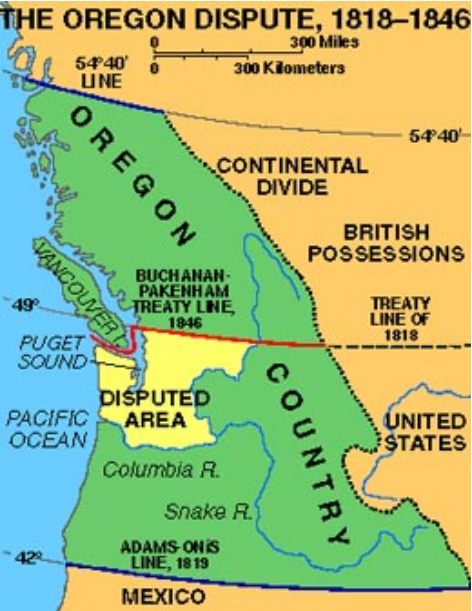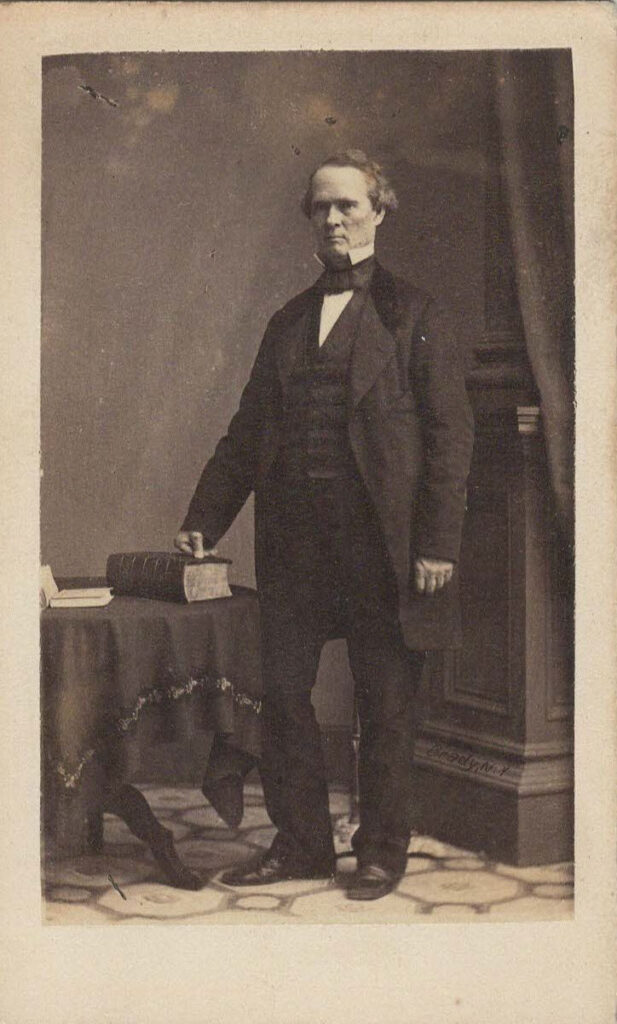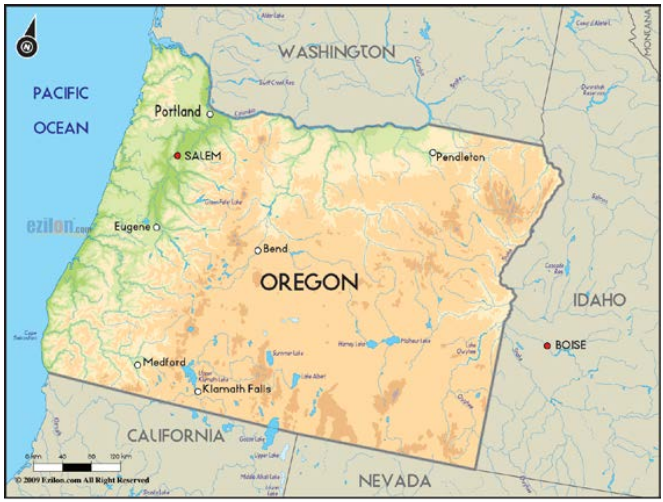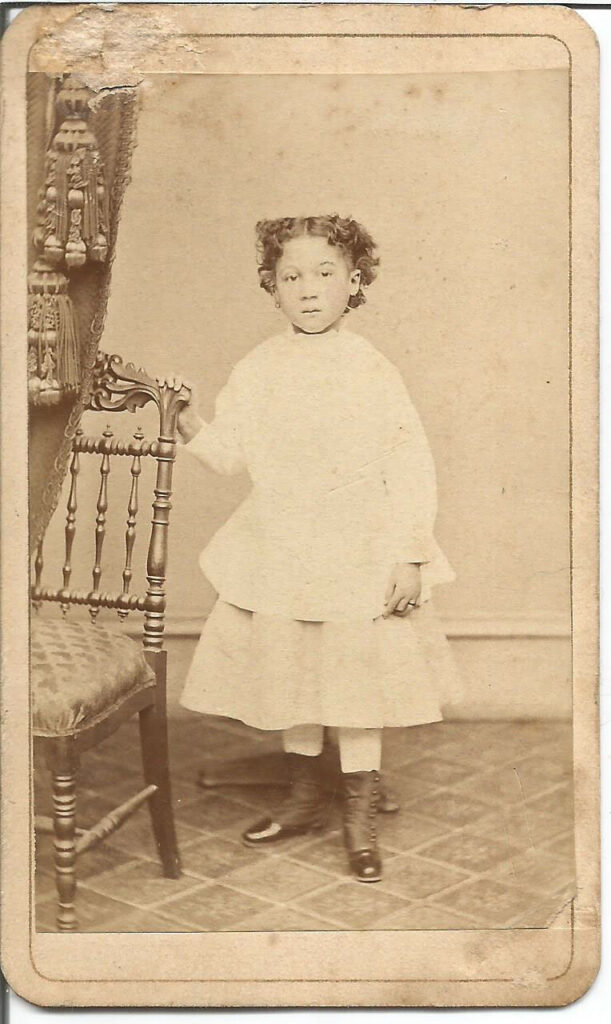Section #19 - Regional violence ends in Kansas as a “Free State” Constitution banning all black residents passes
Chapter 237: Oregon Enters The Union As A “Whites Only” State
August 14, 1848
Congress Establishes The Oregon Territory

While plans are being hatched throughout the 1850’s to blow up the Union, the residents of the Oregon Territory are finally eager to join it.
Their journey has been in the making for over a half century, ever since Merriweather Lewis and William Clark explore the area in their 1805-6 expedition, and John Jacob Astor opens the trading post for his Pacific Fur Trading Company in 1811.
While battles between Astor and Britain’s Hudson Bay Company for dominance of the fur trade continue into the 1830’s, settlers from the east begin to straggle into the area, attracted by the promise of abundant farmland.
On July 5, 1843 they gather together to establish their first provisional government, under a document known as the “Organic Laws of Oregon.”
Soon thereafter the “Oregon Country” becomes the center of national attention in a threatening boundary dispute with Great Britain. It is sparked by the 1844 presidential campaign, where those backing James Polk and “manifest destiny” rally behind the cry of “Fifty-four forty or fight.” Cooler heads prevail in the Oregon Treaty of 1846, negotiated by James Buchanan and establishing the 49th parallel as US-Canadian border.
This begins serious discussions about statehood, and on August 14, 1848, Congress creates the Oregon Territory, stretching all the way from the 42nd to the 49th parallel, and President Polk appoints Joseph Lane as the first Territorial Governor.
March 3, 1849
Joseph Lane Is A Leading Force In The Territory

Lane will dominate the political scene in Oregon for much of the next twelve years — as another of the larger-than-life men of action who emerge during America’s westward expansion.
Joseph Lane is born in North Carolina to a father who fought in the Revolutionary War. His youth is spent in Kentucky where he is self taught. At fifteen he moves to Indiana, marries four year later, operates a successful flat-boat business on the Ohio River.
He reads the law on his own and enters politics at age twenty-two, before enlisting in the Mexican War. Like others his age, the war becomes his pathway to national recognition. He serves under Zachary Taylor, is wounded twice in combat and rises to the rank of Major General.
When Lane arrives in Oregon as the first Governor on March 3, 1849, the total population of the Territory is just under 9,000 people, and battles are frequent with the local Cayuse tribe. He resigns his office in 1850, but then becomes the delegate to the U.S. House from 1851 to 1857 when he is elected as the first of Oregon’s two U.S. Senators.
August 17, 1857
The Constitution Convention Opens

After the land north of the Columbia River becomes the Washington Territory in 1853, the Oregonian’s turn their attention toward statehood. Concerns over federal taxation and land prices have slowed the process, but on June 1, 1857, voters call for a Constitutional Convention by a margin of 7,209 yeas against 1,616 nays.
The convention opens on August 17, 1857 in the town of Salem.
Sixty delegates are chosen to attend. They range in age from 64 years to 25 years old, with a median of around 40.
Age Of Delegates
| Years | # |
| 60 or older | 5 |
| 50-59 | 10 |
| 40-49 | 17 |
| 30-39 | 22 |
| 20-29 | 6 |
Half are farmers; another seventeen are lawyers; the rest have diverse occupations.
Occupation Of Delegates
| # | |
| Farmers | 30 |
| Lawyers | 17 |
| Mechanics | 3 |
| Miners | 3 |
| Surveyors | 2 |
| Physicians | 2 |
| Editor | 1 |
| Printer | 1 |
Their birthplaces are very diverse and divided almost evenly between Free States and Slave States.
Birth State Of Delegates
| Free States | |
| New York | 7 |
| Illinois | 6 |
| Massachusetts | 4 |
| Connecticut | 4 |
| Pennsylvania | 4 |
| Ohio | 3 |
| Others | 4 |
| Total | 32 |
| Slave States | |
| Missouri | 7 |
| Kentucky | 6 |
| Virginia | 5 |
| Tennessee | 4 |
| Others | 4 |
| Total | 26 |
| Europe | 2 |
August- September 1857
Asahel Bush And The “Salem Clique” Dominate The Proceedings
The Democratic Party is dominant in Oregon in 1857, and its members account for just over 75% of the convention delegates. The rest are residual Whigs along with one lone early Republican, a lawyer named John McBride.
Political Party Of Delegates
| # | |
| Democratic | 46 |
| Ex-Whigs | 13 |
| Republican | 1 |
The framework for political debate is largely set by two newspaper publishers, who lock horns throughout the 1850’s.
One is Thomas Dryer, a New Yorker by birth, who comes to California during the gold rush, then moves north in 1850 to found the Oregonian. It is centered in the town of Portland, and dedicated to promoting the Whig agenda. Despite being a notorious alcoholic, Dryer is still able to wield a devastating pen against his political foes.
He is more than matched in this regard by Asahel Bush, originally from Massachusetts, who is recruited by Samuel Thurston — Oregon’s first provisional representative in 1849 to the U.S House – to found a paper backing his political career and helping to organize the Democratic Party. Bush’s paper is the Oregon Statesman, which starts up in Salem in 1851.
Bush himself quickly becomes a leading mover and shaker in Territorial politics, Oregon’s version of publishers like Francis Preston Blair in D.C., Thurlow Weed in Albany, and Horace Greeley in New York City.
Bush parlays his political connections into landing lucrative contracts as the Territorial Printer, charged with publishing all official government notifications. The widespread circulation of his paper, and his personal political acumen, soon attract upcoming Douglas Democrats to his side.
Thomas Dryer christens this group the “Salem Clique,” comprising a dozen or so men, who play a central role in shaping the Oregon Constitution and running the government itself.
A Profile Of Bush And Key Associates In The “Salem Clique”
| Born | Home | Attend | History | |
| Asahel Bush | 1824 | Mass | No | Apprentice printer, passes bar in MA, in ’51 founds Oregon Statesman, builds Democrat Party, head of Salem Clique, backs Stephen Douglas, defends slavery but is pro-Union, later a very successful banker |
| Matthew Deady | 1824 | MD | Yes | Apprentice blacksmith in Ohio, Oregon in ’49, reads law, elected to legislature ’50, President Pierce puts him on state Supreme Court ’53-59, a fierce supporter of slavery |
| Benjamin Harding | 1823 | Pa | No | Illinois lawyer, to Oregon and into legislature ’50, supports Joseph Lane, US Senate ’62-65 |
| James Nesmith N | 1820 | Me | No | Oregon in ’43, law, but never practiced; wealth from gold rush, military captain in several territorial wars vs. tribes, fights alongside Lane; US Marshal ’53-55; Supt of Indian Affairs (’57-59), opposes slavery, US Senate ’61-67 |
| Delazon Smith | 1816 | NY | Yes | Oberlin College but critical of its anti slavery views, lawyer and newspaper editor, from Iowa to Oregon ’52, edits Oregon Democrat, Speaker of legislature ’55-56, U.S. Senator for 3 weeks in ’59, eventually linked to Joseph Lane and Southern Democrats, dies suddenly ’60 |
| Lafayette Grover | 1823 | Me | Yes | Lawyer, Oregon ’51, county clerk and prosecutor, Indian wars, Speaker in legislature, later Governor twice and US Senator |
| Orville Pratt | 1819 | NY | No | West Point, law, practice in Galena, IL, appointed to Oregon Supreme Court by Polk ’48-52, uses positions and influence to advance his considerable fortune, to SF in ’56 as lawyer |
September 18, 1857
The Delegates Vote To Permanently Cleanse Oregon Of All Negroes
The influence of the Salem Clique is apparent right away as delegates choose Matthew Deady to preside over the convention. Two other clique members, Delazon Smith and Lafayette Grover, serve as delegates, as does Thomas Dryer for the opposition.
All told, the event will run for a total of thirty-two days, and produce a constitution modeled on Indiana’s 1851 document, with nine of the final eighteen articles copied word for word and many of the others altered only slightly.
The one topic that draws extensive discussion is the fate of black people within state borders.
Unlike Kansas, the issue of whether or not to allow slavery is never in doubt in Oregon – even though members of the Salem Clique all condone the practice, as does the powerful Joseph Lane.
The public has already signaled its overwhelming wish to become a Free State in the 1843 “Organic Laws,” not because of any moral reservations, but rather to support free white labor. On top of that, all agree that the climate in Oregon is not fit anyway for plantation crops like cotton or sugar.
So there is upfront consensus that no slaves will be permitted in the new state.
But then the question shifts to the fate of “free blacks” already in residence. This is addressed on June 18, 1844, in another stature known as “Peter Burnett’s Lash Law.” According to this law, “free blacks” are ordered to leave the territory, and any who refuse will be subject to a public whipping every six months…
On his or her bare back not less than twenty, nor more than thirty ‘stripes’ to be inflicted by the constable of the proper county.
The prime mover behind this extraordinary act, one Peter Burnett, is a rural Missouri man who immigrates to Oregon in 1843 and enters politics before leaving for the California gold rush in 1848. Once there he makes a fortune selling real estate, before being elected as the state’s first Governor in 1849. While in office he attempts to repeat his “lash law,” but without success.
Having already excluded both slaves and free black residents, all that remains to insure that Oregon becomes a pure white state is to ban the future immigration of any new free blacks – and that’s what the delegates decide to do.
The exact language appears in Article I, Section 35 of the constitution:
No free negro, or mulatto, not residing in this State at the time of the adoption of this Constitution, shall come, reside, or be within this State, or hold any real estate, or make any contracts, or maintain any suit therein; and the Legislative Assembly shall provide by penal laws, for the removal, by public officers, of all such negroes, and mulattoes, and for their effectual exclusion from the State, and for the punishment of persons who shall bring them into the state, or employ, or harbor them.
Before it is passed, an effort is made to also include “Chinamen” in the ban. The sponsor here is William Watkins, a medical doctor from Josephine County, who argues that they pose the same threat to white labor as the slaves:
Chinamen…(are) practically slaves, they are bought and sold to one another, and to white men, as much as negroes were in the south. If Chinese emigration continued to come into (my) county…in five years no white man would inhabit it. White men could not compete with them.
After a lively debate, Watkins finally withdraws his motion, and on September 18, 1857, the delegates are asked to vote on their constitution.
Delegate Votes On Constitution
| # | |
| Voting to accept | 35 |
| Voting to reject | 10 |
| Absent | 15 |
While this endorsement seems a bit lackluster, in the end, 52 of the 60 delegates go on to sign the final document.
November 9, 1857
Public Support For The Constitution And Black Exclusion Is Overwhelming
Criticism of the Constitution comes predictably from Thomas Dryer and his Oregonian, with editorials attacking the outcome as the work of Bush and his henchmen:
A half score of reckless office-hunting knaves in and about Salem, who have too long controlled the political rights of the people of Oregon.
Oregonians seem to brush aside the attacks as more petty bickering between Dryer and Bush, the Portland crowd and the Salem crowd, the ex-Whigs and the Democrats.
Seven weeks after the convention they go to the polls and vote overwhelmingly to approve the Constitution.
Even more telling is the level of support they show for excluding free blacks from taking up residence in the state – a clause that gains 89% of the votes cast.
Oregon Public Voting On November 9, 1857
| Aye | Nay | Total | % Aye | |
| Constitution Itself | 7,195 | 3,215 | 10,410 | 69% |
| Prohibiting Slavery | 7,727 | 2,645 | 10,372 | 74 |
| Excluding Free Blacks | 8,640 | 1,081 | 9,721 | 89 |
Oregon is now set to enter the Union as a pure whites-only state.
As Of 1859
Oregon’s Anti-Black Racism Mirrors The Beliefs Of Most White Americans Over Time

Men like Abraham Lincoln recognize that this wish in Oregon to be “cleansed of all negroes” — not just the slaves — is a sentiment shared by the vast majority of whites in the North, and by many Southerners. It is why he believes that assimilation between the races is out of reach, and continues to favor re-colonization to Africa were it practical.
Expressions of this virulent anti-black racism in Oregon comes in a variety of ways. The Territorial Supreme Court Chief Justice, George Williams, puts it this way at the time of the convention:
Negroes are naturally lazy…. [They] are an ignorant and degraded class of beings, and therefore they will vitiate to some extent those white men who are compelled to work or associate with them.
A more crudely expressed opinion comes earlier from one N. V. Holmes in an 1855 letter to the Oregonian:
Niggers…should never be allowed to mingle with the whites. They would amalgamate and raise a most miserable race of human beings. If niggers are allowed to come among us and mingle with whites, it will cause a perfect state of pollution. Niggers always retrograde, until they get back to the state of barbarity from whence they originated… The Almighty has put his mark on them, and they are a different race of human beings. Let any gentleman read the history of a physician that has dissected a nigger and see what you will find: their very brain is tinctured with black.
Nothing in these beliefs is particularly new – and for six decades they have been converted into countless statutes and policing policies aimed at discouraging black from taking up residency within state boundaries.
These so-called “black codes” are passed by legislatures from Ohio to Oregon.
Statutes Discouraging Black Residency
| Northern States | Years Approved |
| Ohio | 1804, 1807 |
| Illinois | 1819, 1829, 1853 |
| Michigan | 1827 |
| Indiana | 1831, 1852 |
| Iowa | 1839 |
| Oregon | 1849, 1859 |
| Kansas | 1855 |
But Oregon is the first to actually write a ban on all blacks into their constitution. And the ban there will prove to be very effective.
Results of the 1860 Census show that only 126 negroes or mulattoes appear on the state rolls, out of a total population of 52,456. One hundred year later, in 1960, less than 1% of all Oregonians are black.
February 14, 1859
Congress Admits Its First “Whites-Only” State Into The Union
Oregon assumes that its admission to the Union will follow rapidly after the constitution is approved in November 1857 – and they proceed to elect their first slate of government officials.
Two familiar faces are picked for the U.S. Senate. One is Joe Lane, whose national credentials are already well established. The other is Delazon Smith, who soon falls under Lane’s spell and turns on his former colleagues in the “Salem Clique” to wrest control from Asahel Bush over the Democratic Party machine.
The choice for Governor is John Whitacre, another pro-slavery sympathizer, who moves from Indiana during the gold rush, and serves as a probate court judge before entering the Oregon legislature.
Together with congressman Lafayette Grover, these men lobby Congress for a speedy admission process.
But this is not to be.
In the Senate, southerners led by Jefferson Davis, object to any further disruptions to the balance of power, given that Oregon would become the 18th Free State against only 15 Slave States. This delay lasts until March, 1858, when proponents win by a 35-17 margin.
The bill to admit lingers in the House, including a six month long recess running from June 16 to December 6, 1858. By the time the second session opens, the Republicans are already on their way to winning a plurality in the chamber. A few raise concerns about the black exclusion clause, but most of the controversy is focused on the fact that Oregon’s current population, pegged at 42,862, falls well below the established 93,000 minimum threshold, debated in April during the “English Bill” controversy.
Finally, after a fifteen month delay, enough Republican hold-outs join the Democrats in passing the bill on a 114 to 103 vote.
Votes To Admit Oregon
| Aye | Nay | |
| US Senate | 35 | 17 |
| US House | 114 | 103 |
When James Buchanan adds his signature on February 14, 1859, America welcomes its first “whites-only” state into the Union.